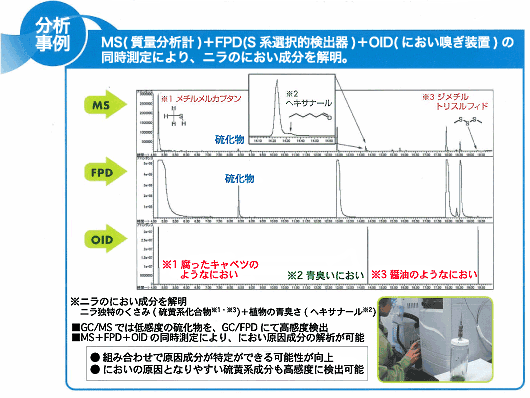In recent years, the quality of our living environment has improved, and the trend has been to seek out greater comfort.
"Odor" can be mentioned as one indicator expressing comfort, and due to factors such as people's preference for no odors, interest in odors has reached an extremely high level.
However, it has been regarded as extremely difficult to quantitatively ascertain odors through equipment analysis.
At our company, we conduct investigations for odor analysis using the idea of "odor units" for data from equipment analysis.
Background / Related Laws / Regulation / Revision
The concept of odor
- Odor components, detected by one of the five human senses, are currently said to extend to approximately 400,000 types.
- Generally speaking, odor components are said to be substances with a molecular weight of around 20-400.
- With our olfactory sense, we register smells as compound odors made up of a mixture of multiple odor components.
Properties of odors
- Quality varies due to changes in concentration and formation of mixed odors.
- Sensations from the human nose vary proportionally with the logarithm of the component concentration.
- Even if a component concentration decreases by 90%, the sensation from the human nose is only about halved.
Here, we will show an amazing thing about the odor components registered by the olfactory sense, i.e., an example where the quality is completely different depending on the odor concentration and chemical structure.
References
- M. Kawasaki, T. Horiuchi: The Olfactory Sense and Odor Substances (1998) (in Japanese)
- S. Haze, Y. Gozu: On Body Odors: From a Biological Perspective, Odor Control Association Journal, Vol. 31, No. 2, 77-85 (2000) (in Japanese)
Features of odor evaluation method
- Causative components are investigated by using the concept of "odor units" (= component concentration ÷ olfactory threshold)
- Can handle a wide range of sample forms using sampling and analysis techniques.

Odor component threshold
In an odor, each component has a threshold, and the minimum concentration whose presence can be detected is called the "detection threshold" and the concentration enabling identification of the type of odor is called the recognition threshold.
The following shows examples of the detection thresholds of typical components.
Examples of odor component detection thresholds
| compounds | threshold (ppm) | compounds | threshold (ppm) |
|---|---|---|---|
| formaldehyde | 0.5 | dimethyl sulfide | 0.003 |
| acetaldehyde | 0.0015 | dimethyl disulfide | 0.0022 |
| propionaldehyde | 0.001 | methyl mercaptan | 0.00007 |
| methanol | 33 | ammonia | 1.5 |
| ethanol | 0.52 | trimethylamine | 0.000032 |
| geosmin | 0.0000065 | indol | 0.0003 |
| propionic acid | 0.0057 | n-propane | 1500 |
| n-butyric acid | 0.00019 | benzene | 2.7 |
| n-valeric acid | 0.000037 | acetone | 42 |
| hydrogen sulfide | 0.00041 | ethyl methyl ketone | 0.44 |
References
- Y. Nagata, N. Takeuchi: Results of Measuring Threshold of Odor Substances Using the Triangle Odor Bag Method, 29th Proceedings of the Japan Society of Air Pollution, 528 (1998) (in Japanese)
- G. Leonardos, D. Kendall, N. Barnard: Odor Threshold Determination of 53 Odorant Chemicals, J. Air Poll. Control Association, 19, 2, 91-95 (1969)
Technical News
Contact Us for Services
For inquiries and requests concerning services of analysis, measurements, products and consulting, please contact us via inquiry form.
